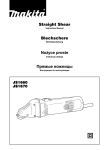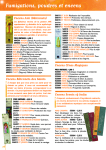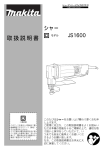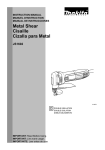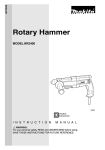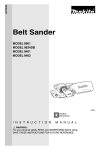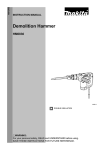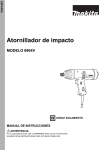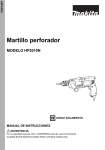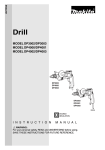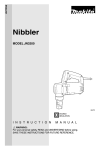Download Makita JS1600 Specifications
Transcript
ENGLISH Shear MODEL JS1600 004665 DOUBLE INSULATION I N S T R U C T I O N M A N U A L WARNING: For your personal safety, READ and UNDERSTAND before using. SAVE THESE INSTRUCTIONS FOR FUTURE REFERENCE. SPECIFICATIONS Model JS1600 N/mm2 1.6 mm (16 ga.) Steel up to 600 N/mm2 1.2 mm (18 ga.) N/mm2 0.8 mm (22 ga.) Steel up to 400 Max. cutting capacities Steel up to 800 Aluminum up to 200 N/mm2 Min. cutting radius 2.5 mm (13 ga.) 30 mm Strokes per minute (min-1) 4,000 Overall length 230 mm Net weight 1.7 kg Safety class /II • Due to our continuing programme of research and development, the specifications herein are subject to change without notice. • Note: Specifications may differ from country to country. SYMBOLS END201-2 The following show the symbols used for the equipment. Be sure that you understand their meaning before use. ...................Read instruction manual. ...................DOUBLE INSULATION ..................Only for EU countries Do not dispose of electric equipment together with household waste material! In observance of European Directive 2002/96/EC on waste electric and electronic equipment and its implementation in accordance with national law, electric equipment that have reached the end of their life must be collected separately and returned to an environmentally compatible recycling facility. Intended use The tool is intended for cutting sheet steel and stainless sheet steel. Power supply The tool should be connected only to a power supply of the same voltage as indicated on the nameplate, and can only be operated on single-phase AC supply. They are double-insulated in accordance with European Standard and can, therefore, also be used from sockets without earth wire. 2 For European countries only Noise and Vibration The typical A-weighted sound pressure level is 81 dB (A). Uncertainty is 3 dB(A). The noise level under working may exceed 85 dB (A). – Wear ear protection. – The typical weighted root mean square acceleration value is not more than 2.5 m/s2. These values have been obtained according to EN60745. EC-DECLARATION OF CONFORMITY We declare under our sole responsibility that this product is in compliance with the following standards of standardized documents, EN60745, EN55014, EN61000 in accordance with Council Directives, 89/336/EEC, 98/37/ EC. Yasuhiko Kanzaki CE 2005 Director MAKITA INTERNATIONAL EUROPE LTD. Michigan Drive, Tongwell, Milton Keynes, Bucks MK15 8JD, ENGLAND Responsible manufacturer: Makita Corporation Anjo Aichi Japan GENERAL SAFETY RULES GEA001-3 WARNING: Read all instructions. Failure to follow all instructions listed below may result in electric shock, fire and/or serious injury. The term “power tool” in all of the warnings listed below refers to your mains-operated (corded) power tool or batteryoperated (cordless) power tool. SAVE THESE INSTRUCTIONS Work area safety 1. Keep work area clean and well lit. Cluttered and dark areas invite accidents. 2. Do not operate power tools in explosive atmospheres, such as in the presence of flammable liquids, gases or dust. Power tools create sparks which may ignite the dust or fumes. 3. Keep children and bystanders away while operating a power tool. Distractions can cause you to lose control. Electrical safety 4. 10. Use safety equipment. Always wear eye protection. Safety equipment such as dust mask, non-skid safety shoes, hard hat, or hearing protection used for appropriate conditions will reduce personal injuries. 11. Avoid accidental starting. Ensure the switch is in the off-position before plugging in. Carrying power tools with your finger on the switch or plugging in power tools that have the switch on invites accidents. 12. Remove any adjusting key or wrench before turning the power tool on. A wrench or a key left attached to a rotating part of the power tool may result in personal injury. Power tool plugs must match the outlet. Never modify the plug in any way. Do not use any adapter plugs with earthed (grounded) power tools. Unmodified plugs and matching outlets will reduce risk of electric shock. 13. Do not overreach. Keep proper footing and balance at all times. This enables better control of the power tool in unexpected situations. 5. Avoid body contact with earthed or grounded surfaces such as pipes, radiators, ranges and refrigerators. There is an increased risk of electric shock if your body is earthed or grounded. 14. Dress properly. Do not wear loose clothing or jewellery. Keep your hair, clothing, and gloves away from moving parts. Loose clothes, jewellery or long hair can be caught in moving parts. 6. Do not expose power tools to rain or wet conditions. Water entering a power tool will increase the risk of electric shock. 7. Do not abuse the cord. Never use the cord for carrying, pulling or unplugging the power tool. Keep cord away from heat, oil, sharp edges or moving parts. Damaged or entangled cords increase the risk of electric shock. 15. If devices are provided for the connection of dust extraction and collection facilities, ensure these are connected and properly used. Use of these devices can reduce dust-related hazards. 8. When operating a power tool outdoors, use an extension cord suitable for outdoor use. Use of a cord suitable for outdoor use reduces the risk of electric shock. Personal safety 9. Stay alert, watch what you are doing and use common sense when operating a power tool. Do not use a power tool while you are tired or under the influence of drugs, alcohol or medication. A moment of inattention while operating power tools may result in serious personal injury. Power tool use and care 16. Do not force the power tool. Use the correct power tool for your application. The correct power tool will do the job better and safer at the rate for which it was designed. 17. Do not use the power tool if the switch does not turn it on and off. Any power tool that cannot be controlled with the switch is dangerous and must be repaired. 18. Disconnect the plug from the power source and/ or the battery pack from the power tool before making any adjustments, changing accessories, or storing power tools. Such preventive safety measures reduce the risk of starting the power tool accidentally. 3 19. Store idle power tools out of the reach of children and do not allow persons unfamiliar with the power tool or these instructions to operate the power tool. Power tools are dangerous in the hands of untrained users. 20. Maintain power tools. Check for misalignment or binding of moving parts, breakage of parts and any other condition that may affect the power tools operation. If damaged, have the power tool repaired before use. Many accidents are caused by poorly maintained power tools. 21. Keep cutting tools sharp and clean. Properly maintained cutting tools with sharp cutting edges are less likely to bind and are easier to control. 22. Use the power tool, accessories and tool bits etc. in accordance with these instructions and in the manner intended for the particular type of power tool, taking into account the working conditions and the work to be performed. Use of the power tool for operations different from those intended could result in a hazardous situation. Service 23. Have your power tool serviced by a qualified repair person using only identical replacement parts. This will ensure that the safety of the power tool is maintained. 24. Follow instruction for lubricating and changing accessories. 25. Keep handles dry, clean and free from oil and grease. ADDITIONAL SAFETY RULES FOR TOOL 1. Hold the tool firmly. 2. 3. 4. Secure the workpiece firmly. Keep hands away from moving parts. Edges and chips of the workpiece are sharp. Wear gloves. It is also recommended that you put on thickly bottomed shoes to prevent injury. Do not put the tool on the chips of the workpiece. Otherwise it can cause damage and trouble on the tool. 5. 6. 7. 8. 9. SAVE THESE INSTRUCTIONS 4 ENB011-2 Do not leave the tool running. Operate the tool only when hand-held. Always be sure you have a firm footing. Be sure no one is below when using the tool in high locations. Do not touch the blade or the workpiece immediately after operation; they may be extremely hot and could burn your skin. Avoid cutting electrical wires. It can cause serious accident by electric shock. FUNCTIONAL DESCRIPTION • CAUTION: Always be sure that the tool is switched off and unplugged before adjusting or checking function on the tool. Switch action • 004671 1 CAUTION: Before plugging in the tool, always check to see that the switch lever (paddle switch) actuates properly and returns to the “OFF’’ position when released. For tools with pivot type lock-off lever CAUTION: The switch lever does not actuate when the lock-off lever is in the LOCK position. Do not try to actuate the switch lever when the lock-off lever is in the LOCK position. • When not operating the tool, keep the lock-off lever in the LOCK position. To prevent the switch from being accidentally actuated, a lock-off lever is provided. To start the tool, turn the lock-off lever to the FREE position and then squeeze the switch lever. Release the switch lever to stop. • 2 1. Lock-off lever in the FREE position 2. Switch lever (Paddle switch) 004672 1 1. Lock-off lever in the LOCK position 004673 For tools with slide type lock-off lever To prevent the switch from being accidentally actuated, a lock-off lever is provided. To start the tool, slide the lock-off lever in the direction of the arrow and squeeze the switch lever. Release the switch lever to stop. 1 2 1. Lock-off lever 2. Switch lever 5 004674 1 Permissible shearing thickness The groove on the yoke serves as a thickness gauge for shearing mild or stainless steel plate. If the material fits within the groove, it is shearable. The thickness of materials to be sheared depends upon the type (strength) of the material. The maximum shearing thickness is indicated in the table below in terms of various materials. Attempting to shear materials thicker than indicated will result in tool breakdown and/or possible injury. Keep within the thickness shown in the table. 2 006425 1. Gauge for stainless: 1.2 mm (3/64”) 2. Gauge for mild steel: 1.6 mm (1/16”) ASSEMBLY • Material Tensile Strength (N/mm2) Max. cutting thickness (mm) Mild steel (A) Hard steel (B) Stainless steel Aluminum plate 400 600 800 200 1.6 (16 ga) 1.2 (18 ga) 0.8 (22 ga) 2.5 (13 ga) CAUTION: Always be sure that the tool is switched off and unplugged before carrying out any work on the tool. Blade inspection Before using the tool, check the blades for wear. Dull, worn blades will result in poor shearing action, and the service life of the tool will be shortened. Rotating or replacing blades Both the upper and lower blades have four cutting edges on each side (the front and back). When the cutting edge becomes dull, rotate both the upper and the lower blades 90° to expose new cutting edges. 004678 1 2 3 4 1. 2. 3. 4. 5. 6 5 Lower blade Loosen Upper blade Upper blade securing bolt Hex wrench When all eight edges are dull on both the upper and lower blades, replace both blades with new ones. Each time blades are rotated or replaced, proceed as follows. Remove the blade securing bolts with the hex wrench provided and then rotate or replace the blades. 004680 1 Some tools have one or more thin washers between the upper blade and the blade holder. Be sure to use the same number of thin washers when reassembling. NOTE: • 2 No thin washers are used for the lower blade. 3 4 1. 2. 3. 4. Thin washers Blade holder Upper blade Upper blade securing bolt 004681 Install the upper blade and tighten the upper blade securing bolt with the hex wrench. Press up on the upper blade while tightening it. 1 2 3 1. Tighten 2. Upper blade securing bolt 3. Upper blade 004683 After securing the upper blade, be sure that there is no gap left between the upper blade and the bevelled surface of the blade holder. 1 4 2 3 1. 2. 3. 4. Blade holder Upper blade securing bolt Upper blade No gap allowed 7 004686 2 3 1 When installing the lower blade onto the yoke, the lower blade should be pressed against the yoke so as to be contacting the bevelled portions A and B of the yoke and the tip C of the lower blade positioning screw while you tighten the lower blade securing bolt. There must be no clearance between A, B and C during installation. NOTE: • The lower blade positioning screw is factory-assembled. Do not tamper with it. 1. Lower blade 2. Tighten 3. Yoke 004687 1 3 A B C 2 1. Yoke 2. Lower blade positioning screw 3. Lower blade OPERATION 004699 Holding material The materials for cutting should be fastened to the workbench by means of workholders. 1 1. Workholder 004701 Shearing method Keep the shear moving parallel with the material. 8 004703 Maximum cutting width Stay within the specified maximum cutting width (A): Case of length 1,800 mm. 006430 A 1800 mm (70-7/8”) Mild steel (thickness) Max. cutting width (A) 1.6 mm 100 mm Under 1.2 mm No limit Stainless (thickness) Max. cutting width (A) 1.2 mm 80 mm Under 1.0 mm No limit 1 1. Cutting line Minimum cutting radius Minimum cutting radius is 30 mm when cutting 1.0 mm mild steel. MAINTENANCE • 001145 CAUTION: Always be sure that the tool is switched off and unplugged before attempting to perform inspection or maintenance. Replacing carbon brushes Remove and check the carbon brushes regularly. Replace when they wear down to the limit mark. Keep the carbon brushes clean and free to slip in the holders. Both carbon brushes should be replaced at the same time. Use only identical carbon brushes. 1 1. Limit mark 004705 1 Use a screwdriver to remove the brush holder caps. Take out the worn carbon brushes, insert the new ones and secure the brush holder caps. To maintain product SAFETY and RELIABILITY, repairs, any other maintenance or adjustment should be performed by Makita Authorized Service Centers, always using Makita replacement parts. 2 1. Screwdriver 2. Brush holder cap ACCESSORIES CAUTION: These accessories or attachments are recommended for use with your Makita tool specified in this manual. The use of any other accessories or attachments might present a risk of injury to persons. Only use accessory or attachment for its stated purpose. If you need any assistance for more details regarding these accessories, ask your local Makita service center. • • Blades • Hex wrench 9 Memo 10 Memo 11 Makita Corporation Anjo, Aichi, Japan 883248B223












